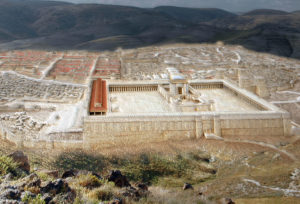I KNOW HOW TO IRRITATE an Old Testament prof.
Ask the question Nick Almendarez did, which becomes the Bible Question of the Week.
Nick, you get a free book for your trouble, though an Old Testament prof might say what you really need is a good talking to. Email or message me. For info on the book, not for a good talking to.
Here’s Nick’s question.
Do you think the more we study the Old Testament part of the Bible the more Jesus is revealed throughout the Old Testament and New Testament in all kinds of nooks and cranny’s?
No I don’t. But I’ve been wrong before.
When I was working for the newspaper, we got a new writer who was more writer than reporter. I remember hearing her talk about a story she was excited to cover. Bubbling, she asked the woman’s page editor sitting at the desk beside her if she’d like to hear the story’s lead—the first sentence.
This was before she covered the story or interviewed anyone.
I didn’t say it. But I thought it.
“Why bother going to cover the story if you’ve already got the most important part of it written?”
She’s probably working for Fox News now.
Here’s what irritated me about her approach to news, and what irritates Old Testament profs about people digging into the pages of the Jewish Bible with the hopes of finding Jesus:
When you’re looking for something you want to find, you can miss what’s really there.
I know Old Testament profs who don’t even like what the writer of the Gospel of Matthew did by claiming he found Jesus in about 60 passages of the Old Testament. Some of those passages read like a stretch, the profs say.
For example, the Gospel writer—let’s call him Matthew, since early church tradition says this disciple of Jesus was the writer—seemed to stretch one prophecy in an odd way. And stretching Jesus in the process. Matthew has Jesus riding two donkeys at once.
Which would have made this Jesus’ first rodeo.
“Look, your king is coming to you, humble, and mounted on a donkey, and on a colt, the foal of a donkey,” (Matthew 21:5).
The problem, it seems to some, is that Matthew didn’t understand Hebrew poetry.
Heck, why should he. He was a tax collector.
Matthew was trying to link Jesus to a prophecy from 500 years earlier:
“Shout aloud, O daughter Jerusalem! Lo, your king comes to you; triumphant and victorious is he, humble and riding on a donkey, on a colt, the foal of a donkey,” (Zechariah 9:9).
Matthew read that the king in this ancient prophecy was riding on a donkey AND a colt. And he took it literally.
If Matthew hadn’t skipped poetry class, some Old Testament profs say, he would have realized Hebrew parallelism when he saw it.
English poems often rhyme words. But Hebrew poetry rhymes ideas. You’ll have a line, followed by a second line that might repeat the idea of the first line, or contrast the idea.
The king rode one donkey. It was a colt. A young guy horse. Not a guy horse and a friend.
John’s Gospel shows more poetic savvy. Quoting the same prophecy, John said, “Jesus found a young donkey and sat on it,” (John 12:14).
Some Bible scholars acting as Matthew’s wing man say there were two donkeys: a mom and her foal.
The point that many Old Testament profs would make is that there are plenty of prophecies that throw a light on Jesus. Some prophecies Jesus himself pointed out.
Why go looking for more?
Why not read the Bible for all it’s worth? With an open mind, instead of an agenda.
Otherwise, some scholars would argue, the Bible’s not talking to us. We’re talking to the Bible.
Look for Jesus wherever he shows up, some of my Old Testament prof friends would say. No need to imagine him in stories that have nothing to do with him.
Seek the Lord while you can find him.
Call on him while he is near.
But don’t expect to find him under every rock.
He’s the Rock of Ages. Isn’t that enough?
The Isaiah quote, by the way, is Hebrew parallelism. The first line gets repeated in the second.
Not that I’m smarter than Matthew.
But possibly more of a poet. Though I can’t be certain I’d know it.





Steve,
A question from the answer from today’s question you answered. What do we do with the Gospels that has Jesus talking with Pharisees and Scribes when Jesus said to them that you search the Scriptures for Him and you cannot see the trees inside the forest? or How about on the road to Emmaus whe Jesus shared about Him through The Law, Psalms, and Prophets? Oops! Two questions, not one!
Hi, Gary. You’re right. There are plenty of trees in the Old Testament with Jesus’ name carved all over them. But I think what some Old Testament profs object to is that some folks see Jesus in all the nuts hanging on the trees, too.
Stephen Miller, I’m sorry to say, but you sound like a fool. How did Timothy come to faith in Jesus the Messiah if it were NOT for the Old Testament.
Paul writes to Timothy, 2 Timothy 3:14-17 (ESV)
14 But as for you, continue in what you have learned and have firmly believed, knowing from whom you learned it
15 and how from childhood you have been acquainted with the sacred writings, which are able to make you wise for salvation through faith in Christ Jesus.
16 All Scripture is breathed out by God and profitable for teaching, for reproof, for correction, and for training in righteousness,
17 that the man of God may be complete, equipped for every good work.
Timothy came through faith through the sacred writings, the Old Testament, because there was NO New Testament at that point. Paul also says that “ALL SCRIPTURE” IS breathed out by God and is profitable….for training in righteousness.
I suspect Timothy came to faith mainly because of what Paul had to say about his Damascus Road experience, and Paul’s reinterpretation of his Jewish religion because of that experience. The miracles Paul did probably didn’t hurt in convincing Timothy either.
The point I was trying to make is that we should read the Old Testament with an open mind. We shouldn’t go there with the idea that we’re going to find Jesus showing up one way or another in every chapter.